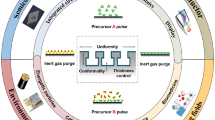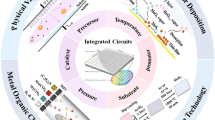Abstract
A simple, inexpensive and wafer-scale method to obtain Si microstructures is proposed. The method consists in a sequence of steps that include a selective metal-assisted chemical etching process to create regions of Si nanowires that are sacrificed in a post-etching process, leaving microstructures standing. As a proof of concept, Si micropillars with length of 7 µm and diameter of 1.4 µm were fabricated. The advantage of the proposed method is its simplicity, allowing the production of microstructures in a basic chemical laboratory.







Similar content being viewed by others
References
Howe RT (1988) Surface micromachining for microsensors and microactuators. J Vac Sci Technol B 6:1809–1813
Higurashi E, Ukita H, Tanaka H, Ohguchi O (1994) Optically induced rotation of anisotropic micro-objects fabricated by surface micromachining. Appl Phys Lett 64:62209–62210
Sze S (2008) Lithography and etching. In: Sze S (ed) Semiconductor devices: physics and technology. Wiley, New York, pp 404–451
Mahalik N (2008) Micromanufacturing and nanotechnology. Springer, Berlin
Johnstone R, Parmaswaran A (2004) An introduction to surface-micromachining. Springer, New York
Kusdterer J, Kohn E (2009) CVD diamond MEMS. In: Sussmann R (ed) CVD diamond for electronic devices and sensors. Wiley, London, pp 469–548
Wolffenbuttel RF (1996) Development of compatible micromachining processes in silicon. In: Wolffenbuttel RF (ed) Silicon sensors and circuits: on-chip compatibility. Springer, London, pp 55–114
Ataka M, Omodaka A, Fujita H (1993) A biomimetic micro motion system-a ciliary motion system. In: Proceeding of the international conference on transducers, Yocohama
Shimaoka K, Tabata O, Kimura K, Sugiyama S (1993) Micro diaphragm pressure sensor using polysilicon sacrificial layer etch-stop technique. In: Proceeding of the international conference on transducers, Yokohama
Jiang H, Yoo K, Yeh J, Li Z, Tien N (2001) Fabrication of thick silicon dioxide sacrificial and isolation blocks in a silicon substrate. J Micromech Microeng 12:87–95
Lerner B, Perez M, Toro C, Lasorsa C, Rinaldi CA, Boselli A, Lamagna A (2012) Generation of cavities in silicon wafers by laser ablation using silicon nitride as sacrificial layer. Appl Surf Sci 258:2914–2919
Yong D, Gwen L, Peng C, Litian L, Zhijian L (2002) Preparation and etching of porous silicon as a sacrificial layer used in RF-MEMSs devices. In: Proceedings of the international conference on solid-state and integrated-circuit technology, Shanghai
Hedrich F, Billat S, Lang S (2000) Structuring of membrane sensors using sacrificial porous silicon. Sensors Actuators 84:315–323
Amri C, Ouertani R, Hamdia A, Ezzaouia H (2018) Enhancement of electrical parameters in solar grade monocrystalline silicon by external gettering through sacrificial silicon nanowire layer. Mater Res Bull 98:41–46
Convertino A, Cuscuna M, Martelli F (2012) Silicon nanotubes from sacrificial silicon nanowires: fabrication and manipulation via embedding in flexible polymers. Nanotechnology 23:305602
Lee KN, Lee K, Jung S, Lee M, Seong W (2012) Fabrication of metal nanobridge arrays using sacrificial silicon nanowire. J Electr Eng Technol 7:396–400
Li X, Bohn P (2000) Metal-assisted chemical etching in HF/H2O2 produces porous silicon. Appl Phys Lett 77:2572
Liu K, Qu S, Zhang X, Wang Z (2013) Anisotropic characteristics and morphological control of silicon nanowires fabricated by metal-assisted chemical etching. J Mater Sci 48:1755–1762. https://doi.org/10.1007/s10853-012-6936-7
Kim S, Khang D (2014) Bulk micromachining of Si by metal-assisted chemical etching. Small 10:3761–3766
Hildreth O, Lin W, Wong C (2009) Effect of catalyst shape and etchant composition on etching direction in metal-assisted chemical etching of silicon to fabricate 3D nanostructures. ACS Nano 3:4033–4042
Bell T, Gennissen P, DeMunter D, Kuhl M (1996) Porous silicon as a sacrificial material. J Micromech Microeng 6:361–369
Weisse J, Lee C, Kim D, Cai L, Rao P, Zheng X (2013) Electro-assisted transfer of vertical silicon wire arrays using a sacrificial porous silicon layer. Nano Lett 13:4362–4368
Fang H, Wu Y, Zhu J (2006) Silver catalysis in the fabrication of silicon nanowire arrays. Nanotechnology 17:3768–3774
Huang Z, Fang H, Zhu J (2007) Fabrication of silicon nanowire arrays with controlled diameter, length, and density. Adv Mater 19:744–748
Huang Z, Shimizu T, Senz S, Zhang Z, Zhang X, Lee W, Geyer N, Gösele U (2009) Ordered arrays of vertically aligned [110] silicon nanowires by suppressing the crystallographically preferred <100> etching directions. Nano Lett 9:2519–2525
Chang S-W, Chuang V, Boles S, Ross C, Thompson C (2009) Densely packed arrays of ultra-high-aspect-ratio silicon nanowires fabricated using block-copolymer lithography and metal-assisted etching. Adv Funct Mater 19:2495–2500
Peng K, Hu J, Yan Y, Wu Y, Fang H, Xu Y, Lee S, Zhu J (2006) Fabrication of single-crystalline silicon nanowires by scratching a silicon surface with catalytic metal particles. Adv Funct Mater 16:387–394
Harada Y, Li X, Bohn P, Nuzzo R (2016) Catalytic amplification of the soft lithographic patterning of si nonelectrochemical orthogonal fabrication of photoluminescent porous si pixel arrays. J Am Chem Soc 123:8709–8717
Hildreth O, Brown D, Wong C (2011) 3D Out-of-plane rotational etching with pinned catalysts in metal-assisted chemical etching of silicon. Adv Funct Mater 21:3119–3128
Yae S, Morii Y, Fukumuro N, Matsuda H (2012) Catalytic activity of noble metals for metal-assisted chemical etching of silicon. Nanoscale Res Lett 7:352–356
Chartier C, Bastide S, Lévy-Clément C (2008) Metal-assisted chemical etching of silicon in HF–H2O2. Electrochim Acta 53:5509–5516
Yun M (2000) Investigation of KOH anisotropic etching for the fabrication of sharp tips in silicon-on-insulator (SOI) material. J Korean Phys Soc 37:605–610
Quiroga-González E, Ossei-Wusu E, Carstensen J, Föll H (2011) How to make optimized arrays of si wires suitable as superior anode for li-ion batteries. J Electrochem Soc 158:E119–E123
Peng K, Fang H, Hu J, Wu Y, Zhu J, Yan Y, Lee S (2006) Metal-particle-induced, highly localized site-specific etching of Si and formation of single-crystalline Si nanowires in aqueous fluoride solution. Chem Eur J 12:7942–7947
Abouda-Lachiheb M, Nafie N, Bouaicha M (2012) The dual role of silver during silicon etching in HF solution. Nanoscale Res Lett 7:455–459
Bastide S, Quang N, Monna R, Lévy-Clément C (2009) Chemical etching of Si by Ag nanocatalysts in HF–H2O2: application to multicrystalline Si solar cell texturisation. Phys Status Solidi C 6:1536–1540
Li S, Ma W, Zhou Y, Chen X, Xiao Y, Ma M, Zhu W, Wie F (2014) Fabrication of porous silicon nanowires by MACE method in HF/H2O2/AgNO3 system at room temperature. Nanoscale Res Lett 9:196–203
Peng K, Lu A, Zhang R, Lee S (2008) Motility of metal nanoparticles in silicon and induced anisotropic silicon etching. Adv Funct Mater 18:3026–3035
Tsujino K, Matsumura M (2007) Morphology of nanoholes formed in silicon by wet etching in solutions containing HF and H2O2 at different concentrations using silver nanoparticles as catalysts. Electrochim Acta 53:28–34
Choi H, Baek S, Jang HS, Kim S, Oh B, Kim J (2011) Optimization of metal-assisted chemical etching process in fabrication of p-type silicon wire arrays. Curr Appl Phys 11:S25–S29
Geyer N, Fuhrmann B, Leipner HS, Werner P (2013) Ag-mediated charge transport during metal-assisted chemical etching of silicon nanowires. ACS Appl Mater Interfaces 5:4302–4308
Um H, Kim N, Lee K, Hwang I, Seo J, Yu Y, Duane P, Wober M, Seo K (2015) Versatile control of metal-assisted chemical etching for vertical silicon microwire arrays and their photovoltaic applications. Sci Rep 5:11277
Choi K, Song Y, Ki B, Oh J (2017) Nonlinear etch rate of au-assisted chemical etching of silicon. ACS Omega 2:2100–2105
Acknowledgements
This work was funded by Projects CONACyT INFR-2011-1-163153, CONACyT CB-2014-01-243407 and PROMEP BUAP-NPTC-377. The author O. Pérez-Díaz acknowledges the financial support of CONACyT through the scholarship with No. 378447.
Author information
Authors and Affiliations
Corresponding author
Ethics declarations
Conflict of interest
All authors declare that they have no conflict of interest.
Rights and permissions
About this article
Cite this article
Pérez-Díaz, O., Quiroga-González, E. & Silva-González, N.R. Silicon microstructures through the production of silicon nanowires by metal-assisted chemical etching, used as sacrificial material. J Mater Sci 54, 2351–2357 (2019). https://doi.org/10.1007/s10853-018-3003-z
Received:
Accepted:
Published:
Issue Date:
DOI: https://doi.org/10.1007/s10853-018-3003-z




